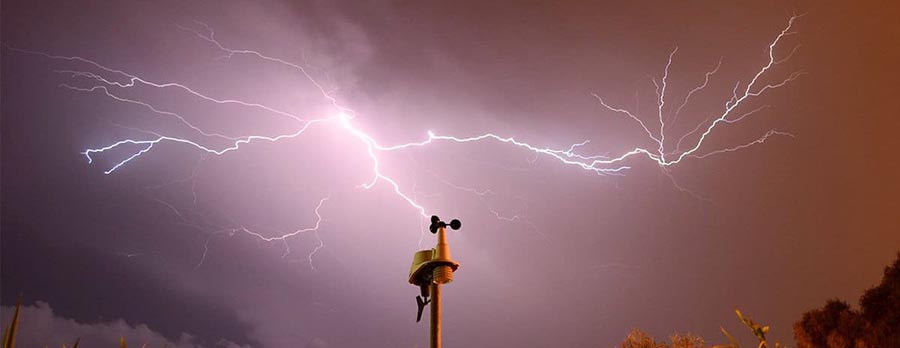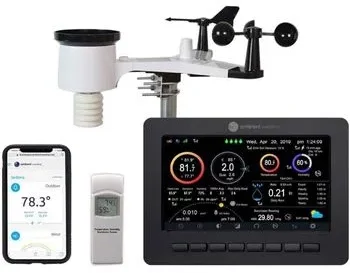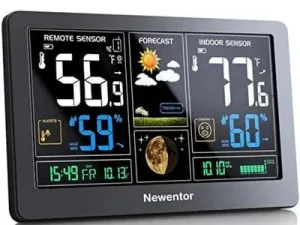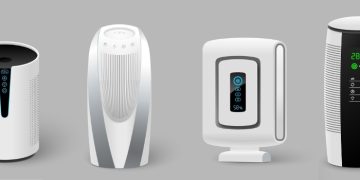With the availability of weather applications on our smartphones, it might not seem necessary to get a home weather station. Well, the truth is that most weather apps provide information based on data that is available at airports, weather centre offices, and other locations that are 10 to 50 miles away from you. Well, since the weather conditions can change within a short distance, most of the information provided by these apps might not be accurate for your immediate location. This is why you must have a home weather station to help you detect the actual weather conditions within your immediate surrounding.
With so many home weather stations on the market, it can be difficult for you to choose the best, which is why in this post, we have researched and gathered 10 of the best home weather stations to help you get the most accurate weather reports for you.
Table of Contents
Home Weather Station Buyer’s Guide:
Before we dive into our list, let’s take a look at certain factors you should consider when you are looking to purchase a home weather station:
Functionality
With functionality, we mean the number of sensors. The number of sensors will determine the number of weather elements the weather station can measure. Generally, ensure that the weather station you purchase measures at least three out of the four most crucial weather elements: wind, rain, and temperature. However, most weather elements on this list can measure five or more.
Transmission Time and Distance
Another essential feature to look out for is the time it takes for the outdoor unit to transmit readings to the receiver (console or hub). Generally, you want to ensure that the outdoor unit transfers data at most 30 seconds; any transmission time more than 30 seconds should be a bad buy. Luckily for you, most of the devices on our list transmit in less than 20 seconds, giving you real-time reports.
Another feature you might want to consider is the transmission distance. Essentially this means how far the console and the outdoor unit can be apart for effective transmission. Most companies would give you an ideal distance, which often means when there is no obstruction between the console and outdoor unit; however, due to the walls and buildings, the ideal transmission distance on the labelling is often affected and shortened. Therefore, we recommend you get a device with an ideal transmission distance of at least 300 feet.
Accuracy
The accuracy of the readings provided by your weather station is another important factor to consider. Generally, professional-grade weather stations are more accurate; hence, they tend to be more pricey than other options. A typical example is the Davis Instrument line of weather stations, which is one of the most expensive options on this list.
Powering Option
Another important thing to look out for is the powering options; this essential means how your outdoor and indoor unit will be powered. Some weather stations are solar-powered whiles others require electricity or both. Therefore, you want to check these features out to choose the one that best suits you.
We have written a comprehensive article on the best solar-powered weather stations so do well to check it out.
Expandability
Expandability becomes crucial if you want to add more sensors than what is offered. Some weather stations allow you to add more 2, 3, 4,5, or more sensors for a more expansive reading. For example, if you are a farmer, you might want to measure the daily soil moisture content of the soil. In this case, you want to check out the compatibility of your weather station with a soil sensor.
Therefore, knowing the number and types of sensors you can integrate into your weather station is crucial.
Phone Compatibility Option
The final thing to check is the compatibility with your phone and WiFi. Sometimes you might be away from home and you want to view the current weather conditions are home, well, some weather stations provide you with an option of viewing a detailed weather report on your phone via their app, while others do not. So, if this might be a feature you want to look out for.
Here Are the 10 Best Home Weather Station Reviews:
1. Ambient Weather WS-2000 Smart Weather Station with WiFi Remote Monitoring and Alerts: Best Home Weather Station Overall
If you are looking for an accurate, durable, and high-quality weather station, then the Ambient WS-2000 smart weather station is what you need. This weather station features a sweet spot between price, functionality, and durability, let’s take a deeper dive to see what it has to offer.
Starting, this weather station features a solar-powered outdoor sensor array, an indoor sensor, and a console. These two sensor suites are engineered to gather information on a wide range of weather conditions. Whiles the outdoor sensor array gathers information on UV and Solar radiation, wind, precipitation, humidity, and temperature, the indoor sensor gathers information on atmospheric pressure, temperature, and humidity. What makes the WS-2000 unique is that it can support a mix and match of 8 different sensors including thermo-hygrometer sensors (WH31E), a lightening detector(WH31L), a leak detector (WH31LA), and 2 additions of air quality; not only does it support these extra sensors, but it also displays any relevant readings from these sensors onto the console.
Talking about the console, all the weather information from the various sensors is gathered, processed, and transmitted to the console in real time. The console features an intuitive full-colour TFT LCD multiscreen display, which displays essential information such as ‘Feel Like’ temperature, humidity, 10 mins average wind speed and direction, temperature, and many more. It also timestamps datestamps, displays, and archives information about any high and low weather conditions throughout the day– which can be later retrieved for personal use.
The outdoor sensor and the console can transmit and receive data from up to 100 ft under normal conditions, and up to 330 feet line of sight in the open air. In case you are far from the console, all you have to do is to download the Ambient Weather Network app on your phone, tablet, or PC, and you should be able to get access to extensive, as well as, summarized data on weather conditions in real-time from your weather station.
2. Logia 7-in-1 Wi-Fi Weather Station with Solar: Best Budget Option
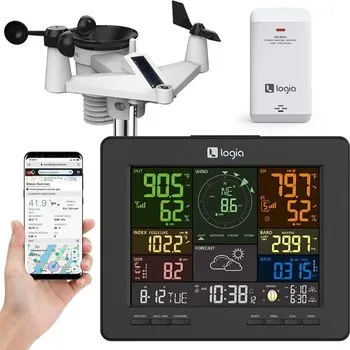
This weather station features 7-in-1 comprehensive outdoor sensor arrays, which can measure all weather elements–humidity, wind, rain, UV intensity, temperature, and barometric pressure– from one station. The outdoor station is robust and can withstand all elements of nature for a very long time. Also, the station is designed to run on a hybrid power system (solar and corded); however, using the solar power consistently would last you a whopping 2.5 years.
The outdoor sensor is easy to mount, and once it is mounted, you can view all information gathered on your console up to 429 feet away from the outdoor sensor array. The console is a full-colour display that features a well-laid-out multiscreen with 11 key readings including: ‘feels like temperature,’ date and day, rainfall rate, moon phase, and many more. All readings are presented in either metric or imperial measurements and are transmitted from the outdoor station to the console within a 12-second and 24-second interval depending on the type of reading it is, giving you readings almost in real-time.
Finally, the inbuilt WiFi integration makes it possible for you to connect your mobile phone and other devices to the weather station’s Weathercloud and Weather Underground servers for live updates on your devices, anywhere you are.
3. Davis Instruments 6250 Vantage Vue Wireless Weather Station: Our Top Premium Choice
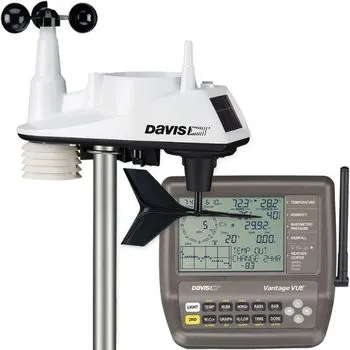
The Davis Instrument 6250 features an extensive and robust solar-powered outdoor sensor array referred to as an Integrated Sensor Suite coupled with an easy-to-use console. The outdoor sensor is easy to install and it can withstand all weather conditions, even in extreme cases. It provides you with information on vital indoor and outdoor weather variables such as temperature, humidity, dew point, rainfall, and many more. Unlike most weather stations, this compact instrument is capable of transmitting all reading to its console every 2.5 seconds–making it 10x faster than most weather stations– and within a range of up to 1000 feet, which is more than what any of the aforementioned choices offer.
The console features a wide backlit screen that allows you to see readings of basic variables such as indoor and outdoor temperature, wind direction and speed, humidity, and many others. All information displayed on the console can be viewed vividly during the day and even at night thanks to its glow-in-the-dark keypads. For those of you who might want in-depth information on each weather variable, all you need to do is to tap on the Weather Center button for all the insight you need. This button also allows you to access all weather information over the past 25 days.
Finally, the Vantage Vue is compatible with sensors from the Davis Vantage Pro 2, and to get access to all your weather information on your phone/web interfaces, you would have to download the WeatherLink data logger. Keep in mind that the information would only be presented to you in the imperial measurement system.
4. Davis Instruments 6163 Vantage Pro2 Plus Wireless Weather Station: Professional Choice
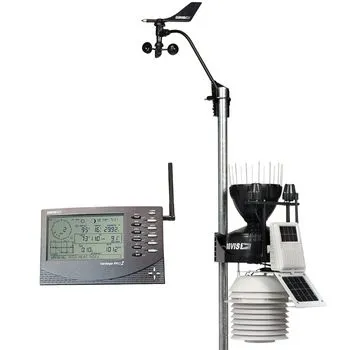
Starting, the station features the Integrated Sensor Suite; however, unlike that of the Vue, each sensor is more prominent for a more accurate and precise reading; however, one feature notable feature that makes the Pro 2 models unique is the presence of bird spikes on the rain gauge to deter birds. The ISS is mainly powered by solar, but you have the option of powering it via electricity.
Similar to the Vantage Vue, the ISS of the Vantage Pro2 Plus transmits information to the console over a 2.5 seconds interval, which can be transmitted over a distance of 1000 feet, and you have the option of extending the range if needed.
The console is simple to use and easy for you to read any information on both indoor and outdoor conditions. Via the console, you can view up to 80 different in-depth graphs of present and past weather variables for up to 24 months prior. You have the option of choosing an alarm for various emergency weather forecasts from up to 70 different alarm settings.
Similarly to the Vantage Vue, you can easily access all your weather information remotely on your devices by downloading the WeatherLink Data Logger app on your window and mobile interfaces.
5. Ambient Weather WS-5000 Ultrasonic Smart Weather Station: Best Ultrasonic Model
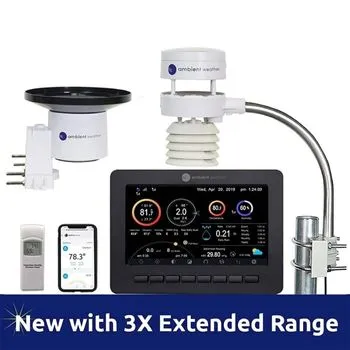
As stated earlier, the design of this weather station is unique, and the solar-powered outdoor sensor suite has been designed to have two main parts: the rain cup and the all-in-one Ultrasonic sensor array. However, just like most weather stations on this list, the ultrasound body together with the rain cup is capable of measuring all essential weather elements. You would be impressed by the timely delivery of results by the outdoor sensor suite since it can read, process, and deliver results to the console every 5 seconds over a distance of up to 1000 feet in line of sight.
The Ws-5000 also features an indoor thermo-hygrometer barometer sensor to monitor indoor pressure, temperature, and humidity. However, one thing everyone likes about Ambient is the user-friendly interface of their consoles. The console features a full-HD TFT full-color LCD to help you view all readings from the indoor thermo-hygrometer sensor and the outdoor sensor suite. The console also features an automatically adjusted light intensity to optimize your viewing experience throughout the day. You can see precisely calculated data obtained from the measured parameters, including: ‘Feel like’ temperature, Dew Point, 10-minute wind speed and direction average, and many more.
All daily data are gathered and archived and can be retrieved whenever you like; also, information about the maximum and minimum conditions of each weather element is displayed with time and date stamps for your knowledge.
Essentially, the Ws-5000 weather station features everything the WS-2000 has, with the difference being the extra large water cup, passive aspiration, and a pagoda thermo-hygrometer radiation shield for enhanced accuracy. Another difference is that with this, you can add 8 additional thermo-hygrometer sensors, 2 air quality sensors, 8 soil meters, 4 leak detectors, and a lightning detector for more expansive weather stations, and all information from these additional sensors can be viewed from the console.
6. Newentor Weather Station Wireless Indoor Outdoor Thermometer: Best Affordable Weather Station
If you are on a tight budget and you want a super affordable weather station, or if you just want a simple weather station, then the Newentor Weather Station is for you. We picked this weather station based on the impressive reviews it had on Amazon from other buyers.
This weather station features two simple units: an indoor receiver (a console) and an outdoor sensor. The outdoor sensor measures basic information such as outdoor temperature, humidity, and atmospheric pressure. All this information can be transmitted over a distance of up to 60 meters from the sensor to the receiver.
The indoor receiver also features an inbuilt thermometer and hygrometer which measures indoor temperatures and humidity. The receiver also features a wide 7.5″ display that showcases well-organized reports from the indoor sensor, the remote sensor, and weather forecast, together with an atomic time, calendar, and clock section.
This weather station only comes with one remote sensor; however, you have the option to add three additional sensors for a more expansive weather reading and forecasting experience.
7. Sainlogic 8-in-1 Wireless Weather Station with Outdoor Sensor
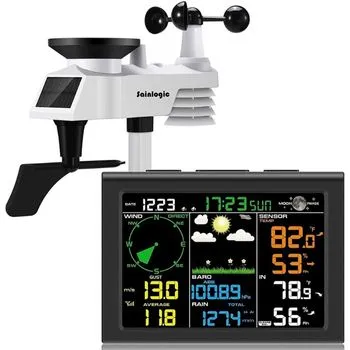
This wireless weather station features a solar-powered 5-in-1 outdoor sensor unit that features a high-precision anemometer, a solar-powered aspiration fan, a rain funnel, optical sensors to track current wind direction, and a wind vane to help you record and forecast readings to keep you prepared for any climatic conditions. The outdoor sensors can take readings and transmit them to the console over a 16 seconds time interval over a distance of 328 feet, given there are no obstructions.
The console features an inbuilt thermo-hygrometer barometer for measuring indoor temperature, atmospheric pressure, and humidity; however, you would love the large clear-colour display of the console. The console displays 10 summarized data of the various essential readings from the sensors with the inclusion of weather forecasts, calendars, alarms, moon phases, and dew. You can also view the maximum and minimum readings of the day, as well as that of previous days.
One highlight feature of this device is its weather forecast feature, which displays the most likely weather conditions for the next 24 to 48 hours. The calculation for the weather forecast is based on the variation in barometric pressure. However, unlike most devices reviewed on this list, the Sainlogic wireless station doesn’t allow you to view weather information from your device on your phone or window interface.
It also features an alarm system for a normal alarm and a temperature alarm to alert you during extreme temperature conditions.
8. AcuRite Iris (5-in-1) Professional Weather Station With LCD

The AcuRite Iris features an easy-to-install corded-powered 5-in-1 outdoor sensor suite that measures temperature, wind speed and direction, atmospheric pressure, rain, and humidity. The outdoor station is can transmit recorded data to the indoor console over a 100-meter distance within an 18 seconds interval.
The most attractive feature of this weather station package is the lightning detector. A lightning detector comes in handy for many activities; however, if you are a recreational pilot or a fisherman who wants to go fishing, then the lightning detector would be a useful tool for you. This lightning detector is capable of detecting lightning strikes that are 40 kilometres away, whether it is cloud-to-cloud lightning or cloud-to-ground lightning. The lightning sensor sends an update to the console every 24 seconds or 8 seconds depending on the presence of lightning or not.
The console is a large intuitive display with in-built sensors that allows you to stream real-time reports of the various readings from the various sensors. The in-built sensors of the console are capable of measuring basic indoor conditions such as temperature and humidity. However, the screen features a comprehensive display of information. The console allows access to the Lightning Detection Weather Station, which is a portal that provides access to in-depth lighting information such as the total number of lightning strikes detected throughout the week and month, the distance at which lightning is most likely to occur, and many more.
The console also showcases a 12-hours hyperlocal weather forecast curated for your exact location to help you plan your day accordingly. The forecast is done by analyzing the change in temperature and pressure of your vicinity for a more accurate result.
9. La Crosse Technology V40A-PRO-INT Wi-Fi Professional Weather Cente
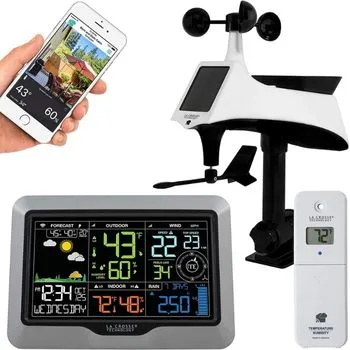
The outdoor unit just like most units on this list features a multisensor unit that supervises and records any changes in climatic conditions of the various weather elements with very good precision. The information gathered can be transmitted over a long-range distance of up to 400 feet to the indoor console. The outdoor sensor together with the thermo-hygrometer sensor gives you an extensive update ensuring you do not get surprised by mother nature.
The inside console features a well-laid-out interface that displays essential outdoor and indoor weather readings, as well as, a forecast of the most likely weather condition for the next 24 hours. However, if you need more details on a particular weather element, you can tap on the push buttons on the top console for an in-depth view, as well as, a history of each element.
Users have the option of freely downloading the La Crosse View app on their devices for remote viewing on your devices anywhere they go. Also, this smart weather station with WiFi allows you to access more features such as detecting snow, thunderstorms, and many others. It also comes with programmable alert settings to keep you alerted in case of any extreme weather conditions; the app allows you to set an alarm for your extreme highs and lows.
10. Tempest Weather System
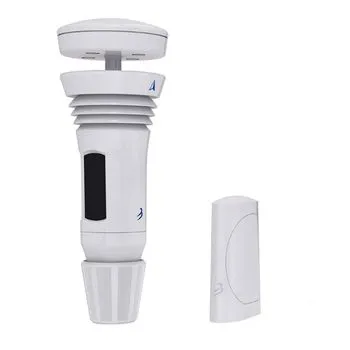
This advanced weather system features two units; an outdoor sensor unit and a transmission hub that sends transmissions to your phone or devices. Starting with the outdoor sensor unit, it has a unique design that houses sensors for measuring all the weather elements. However, one amazing feature of this weather system is that it can integrate into your smart home together with the various voice-controlled virtual assistants, and you can program your smart home to automatically adjust the various devices such as AC, fan, heating, lighting, and other devices once there is a certain change of an element.
Tempest uses AI and ML technologies to continuously improve and tune the accuracy of the weather forecast of your surroundings to ensure that you have the best update needed to plan your day right. Also, the outdoor sensor transmits data to the hub within a 3 seconds interval to ensure that you have all your readings in real time.
By simply downloading the Tempest Weather Application on your devices, you can configure the settings and view all relevant readings from the Tempest Weather System.
Weather Station Maintainance Tips?
Maintaining your weather station is crucial to ensuring that you have a durable station that produces accurate results always. Dirt can always clog up the pores, affecting the functionality of the sensors; therefore, you must employ some maintenance to keep everything running smoothly, also, most of the cleaning would be done on the outdoor monitoring system, and below are some tips to help you achieve that:
- We recommend you clean your weather station twice a year.
- Cover the tip of any of your fingers with damp soft clothing and then clean the diffusers of the solar radiation sensor and the UV sensor. Avoid touching either diffuser with your bare hands, since it can leave oil deposits on the surface of the diffuser, affecting its readings.
- Clean your rain collector, especially if there are no spikes on it at least three times a year. Sometimes, birds poop into the rain collector, and this affects the amount of rain collected, as well as, blocks the sensors of the rain gauge. To clean your rain collector, remove the debris screen, and then get rid of any residues found inside. If your rain collector happens to have bird poop in it, then you would have to remove the rain collecting funnel and then rinse it with soapy water to get rid of the poop. Also, do not forget to clean the tipping bucket and any other openings with a damp cloth.
- The next step will be clean the thermo-hygrometer sensors, and to do this, read the manual on how to access the thermo-hygrometer sensors. Once you get access to it, gently clean the mesh with a soft brush.
- Clean the wind cups of the anemometer and the arrow of the wind vane with a soft damp cloth as well. If the cups or the arrow has hard-to-remove stains, then give each a rinse in mildly warm soapy water.
- Finally, ensure to change the batteries of the outdoor unit–if there are any– as well as the batteries of the console and the other stand-alone sensors.
How Do I Install A Home Weather Station?
So, now you’ve bought your weather station, and you might be wondering about the ideal spot to install it, right? Well, here are a few tips to consider when mounting your weather station:
- Install the outdoor unit of the weather station in an easy-to-access area; this is because in case of a fault or when you need to perform some maintenance work, you do not want to struggle to get to the outdoor unit or sensor array.
- When mounting the weather station, ensure to keep it at least 4-6 feet above the ground or at a height of 6 to 8 feet if you are installing it on a rooftop. The outdoor unit would be affected by wind turbulence if mounted too low on a roof. Also, it will not get enough sunlight exposure if mounted too low on the ground, and the heat from the ground could affect the readings of the thermometer if mounted too low.
- If you are installing the outdoor unit on the ground, ensure that it isn’t too close to the rooftop of the home; this is because the rooftop greatly influences the speed and direction of the wind, and this can affect the reading of the anemometer and wind gauge. Also, avoid mounting the weather station on trees due to the turbulence around trees which can affect wind reading; also, birds might end up building their nest on your weather station.
- The horizontal distance between the outdoor unit of the weather station and any object should be 2 times the height of that object. For example, if the height of your home is 12 feet. then the outdoor unit should be 24 feet away from your home. Ensure to also keep it at least 6 feet away from any sources of heat. This is because heat can affect the sensitivity and accuracy of the sensors.
- For accurate temperature readings, ensure that the sensors of the outdoor unit are aligned with the direction of the sunlight. Also, ensure to keep it away from artificial water sources such as sprinklers, large vegetation, and heat sources for accurate temperature readings.
- Even though the ideal transmission distances for most weather stations are 300 feet, we recommend that you ensure that the distance between your weather station and the console shouldn’t exceed 100 feet. Ensure that there are no metal objects or high voltage lines between the sensor array and the console.
Frequently Asked Questions About Home Weather Stations:
How Many Sensors Do I Need?
The number and type of sensors you need would greatly depend on the reason why you are purchasing the weather station. If it is for professional use, then you might want to look out for certain sensors and the accuracy of those sensors. However, if it is for recreation, then having a 5-in-1 sensor weather station is ideal.
Why Are Some Weather Stations Pricey?
The price of a weather station depends mostly on the accuracy of the sensors, transmission time, the technologies used, and the number of sensors, in that order. So, the more accuracy you need, the more money you would pay.

